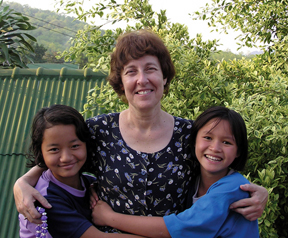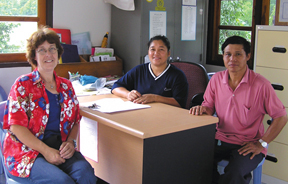People helping themselves
Micro financing attempts to address root causes of poverty for hill tribe peoples in Thailand
By Susan Keays
October 2006
Return to Table of Contents
Print Article
Ten days ago, I bade farewell to the children and staff at the Camillian Social Centre in Chiang Rai and made my way to Chiang Mai, a lovely and historic old city about 150 kilometres south.
My departure from the Centre was far less difficult than I’d expected. The director, Brother Gianni, reassured me that there would always be a place for me there. So in the last weeks and days I had been telling the children that although I was going to live and work in Chiang Mai, I would visit them as often as I could.
The organization I am working with in Chiang Mai is MEDP (Micro Economic Development Project). It is a Christian non-profit organization that attempts to relieve the poverty and powerlessness that plagues the Indigenous here in northern Thailand.
The concept of cooperative saving and lending is an attempt to improve the social and economic conditions of hill tribe communities. The project aims to help communities help themselves by giving them an opportunity to develop projects that are sustainable and that will provide for their livelihood.
 Nongnut and Sawarat, children at the Camillian Social Centre, bid farewell to their teacher, Scarboro missioner Susan Keays who now works with the Micro Economic Development Project helping hill tribe peoples develop sustainable projects to better provide for their livelihood.
Nongnut and Sawarat, children at the Camillian Social Centre, bid farewell to their teacher, Scarboro missioner Susan Keays who now works with the Micro Economic Development Project helping hill tribe peoples develop sustainable projects to better provide for their livelihood.
After introducing the project and its benefits, MEDP returns to the village a month later to hear whether the villagers are interested in starting a financial cooperative and are willing to commit to a savings program. If so, MEDP teaches them everything they need to know, step by step, to form and operate a village cooperative.
This project strikes at the root of the problem for the hill tribe families whose children live and receive schooling at the Camillian Social Centre.
At my farewell feast at the Centre, the children took turns performing songs and dances. I left the next day and the memory will remain with me always.
I had planned to say goodbye before the children went down for their afternoon nap. So after they’d finished lunch, I taught them the difference between “Goodbye” and “See you soon.”
“See you soon” were our farewell words as I turned to walk down the hill and they headed toward their bedrooms on the second floor. From that vantage point, the children could see me on my descent towards my pick-up truck. Draping themselves over the stairs and upper balconies, they called, “See you soon!” again and again, and waved their little hearts out. What a wonderful parting.
Do I miss the children at the Centre? Every single day. But I am heartened by the knowledge that the MEDP’s efforts are working, and that the villages they serve are experiencing relief and are even beginning to thrive. So in more ways than one, I continue to walk with these little ones.
Return to Table of Contents
Print Article
